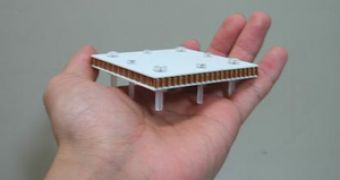Well, it took a while, but now we can finally say good-bye to those pesky wire antennas on our cellular phones, cars and even airplanes, due to a new device developed at the Electronics and Telecommunications Research Institute and the Pohang University of Science and Technology in the Republic of Korea. The smart-skin antenna contains microstrip antennas, which can offer a variety of different antennas, in a patch of material so small that it can fit in the palm of your hand.
"The smart-skin antenna provides a new paradigm where the structural surface becomes an antenna. Because the new kind of antenna is integrated into the structural surface, the antenna can be aerodynamically designed; the appearance is very nice and no outer space is required for the antenna installation. In airplanes, the installation of protruding antennas weakens the mechanical strength of its structure. So the smart-skin antenna can also improve the structural performance," says Woonbong Hwang from the Pohang University of Science and Technology.
The smart-skin is made of organic honeycomb structures, sandwiched between two dielectric layers, is able to radiate radio wavelengths and has a scanning range of 90 degrees. By using multiple antenna microstrips, the bandwidth of the device is increased, also enabling a faster operation. The prototype is able to function at a frequency of 7.5 GHz and has a bandwidth 500 MHz wider.
Amongst other capabilities, the smart-skin antenna can produce directional radiation patterns or even perform electron beam scanning by changing the spacing between antenna microstrips.
"The smart-skin antenna, with a lightweight, durable, and load-bearing structure, could replace the body and roof panels of vehicles. Then, the structural surface itself makes it possible to get services including AM/FM, TV, GPS, Digital Audio Broadcasting, and Digital Multimedia Broadcasting," said Hwang.
Alternatively, the smart-skin antenna could replace the wireless communication systems in consumer electronics devices.
"Traditionally, the necessary antennas are separately installed into the case of the device and are protruded from the case. However, the smart-skin antenna technology is helpful to design the new case with structural-integrated antennas in electronics devices such as cellular phones, laptop computers, etc.," concluded Hwang.

 14 DAY TRIAL //
14 DAY TRIAL //